Providing a predator proof chicken tractor is essential when raising pasture-raised broilers. They are slow, not very smart and a tasty treat to just about any predator out there.
The challenge with pastured poultry operations is that the typical chicken tractor designs tend to be weak and lightweight because they need to move to fresh grass daily. Plus, they are temporary structures for the summer only, so they tend to be simple designs and less robust than a traditional year-round coop.
We’ve been running red rangers since 2015 and have made a lot of modifications to our salatin-style chicken tractor over the years. I think it’s safe to say that it is now completely predator proof! Keep reading to learn my best strategies and tools for protecting your flock.
*Disclosure: This post may contain affiliate links to products (including Amazon). I’ll earn a small commission if you make a purchase through my link, at no additional cost to you! Regardless, I only link to products that I personally use on our homestead or believe in.
Why You Need a Predator Proof Chicken Tractor
Unfortunately, chickens draw in a lot of predators! If you raise chickens, especially broilers, chances are you’ll have a run-in with at least one. Depending on where you live, you may experience issues with predators as small as a mink or rat, or as large as a wolf or bear.
The focus of this article is on deterring predators that will enthusiastically dig under your chicken tractor walls. Below are the most common predators that you’ll deal with in these situations:
- Dog
- Coyote
- Fox
- Mink
- Racoon
- Weasel
The Problem With a Salatin-Style Chicken Tractor
The original Joel Salatin style chicken tractor is a wonderful design as far as functionality goes, but it is lacking in predator-proofing. The biggest fault is that this traditional design only includes straight sides, with no side skirts to prevent predators from digging underneath.
When we built our chicken tractor in 2016, we modified the design by extending the hardware cloth out 6” along the front portion (see photo below). This helped, but over time it has become bent and worn from moving the chicken tractor daily, so it’s not a lasting solution.
We’ve been lucky for 7 years, but this summer our luck took a turn for the worse. A hungry fox burrowed under the back side of our chicken tractor where there wasn’t any skirting. ALL 23 of our 2 week old red ranger chicks were taken and we were devastated! It was time to go back to the drawing board and figure out a better solution.
How to Make a Predator Proof Chicken Tractor
We brainstormed for quite some time trying to decide what would be the best option to provide more protection for our salatin-style chicken tractor. The trickiest part of it all is that the structure has to remain light and be able to move to fresh grass daily. I’ve received a lot of great ideas from my followers (thanks, guys!) on things to try for predator-proofing our chicken tractor and here’s a summary of what I’ve gotten.
Other Predator Proof Chicken Tractor Ideas:
- Adding a wire floor to the chicken tractor: The chickens might injure their feet while scratching, and their foraging will be hindered. Also, the weight of the chickens will be too much for the flooring during the daily moving of the tractor. Lastly, I’m sure there would be a lot of injured toes while moving the chicken tractor 🙁
- Burying the wire skirting 6” into the ground: While this is very effective and what we utilize in our main coop, this is not an option because the chicken tractor has to move daily.
- Placing heavy logs, cinder blocks or bricks around the perimeter: While this would technically work, it would be very cumbersome to move all of them daily as the chicken tractor makes its way across the yard.
- Attach further hardware cloth skirting around the rest of the chicken tractor: This was my original plan until I came up with something better! What I don’t like about having the skirting attached to the chicken tractor is that it can get in the way while moving the structure daily. Plus, it makes storage awkward and the skirting eventually gets worn and weakens overtime.
- Get a livestock guardian dog (LGD): While I LOVE this idea and they can be a great addition to a farm, we just aren’t ready for one, for several reasons. Adding a LGD isn’t a decision that should be taken lightly. Someday, just not yet!
My Idea: Construct a Removable No-Dig Skirt!
Then, one morning it came to me… “What about a removable no-dig skirt that’s lightweight and easy to move?” That was my a-ha moment and the option that we chose to go with. I love that I can quickly move no-dig skirts around, freely move the chicken tractor to fresh grass and then secure them back into place with a brick or two.
The best part was that we already had enough wood scraps and hardware cloth laying around to make it work. A true homesteading make-it-work moment! See it in action via my reel on Instagram.
Materials
- 2″x2″ treated pine or rip 2″x4″ cedar in half (2″x2″ cedar doesn’t exist in pieces longer than 4 feet) – We used basic furring strips because that’s what we had laying around, but if I were going to the store to get materials, I would chose 2″x2″ lumber so that the no-dig skirts don’t flop around as much while moving them. I don’t think our current build is going to last more than a year, but it’ll work for now!
- Hardware mesh – this is stronger than chicken wire and will not only provide more protection, but will add stability to each no-dig skirt so that they last longer. I like the 24″ width so that it can be cut in half for each 12″ wide no-dig skirt.
- 2 1/2″ or 2 3/4″ deck screws
- Staples or light gauge u-nails
- Bricks or Pavers (anything heavy) x 8 – this will hold the removable no-dig skirts in place. Use whatever you have laying around!
Tools
- Tin Snips
- Power Drill or screw driver
- Miter Saw (optional – can have lumber cut at building supply store and use a pull saw to cut the lumber to fit)
- Staple Gun – if using staples
- Tape Measure
Steps for making a removable no-dig skirt
*I didn’t offer any measurements or lengths for this project since everyone’s chicken tractor size and set-up is unique.
Step #1: Measure your chicken tractor sides to identify what length each of your 4 no-dig skirt panels should be. The width should always be 12″ to protect against digging predators, regardless of your chicken tractor design. Make sure to account for overlap on each corner so that there isn’t a gap (see final photo for an example of this).
Step #2: Cut your wood pieces to length using a miter saw and secure together with screws and your power drill. If your no-dig skirts need to be >8′ long and all that’s available is 8′ long boards, you will need to make a splice section. Make sure that you are working on a solid, flat surface! Most thin lumber like this has some warp to it, so don’t worry if it’s a little wonky. When you put the bricks on them it will flatten them out.
Step #3: Flip the no-dig skirt over and lay out a piece of hardware mesh. Cut the hardware mesh to fit using tin snips (these work SO much better than wire cutters, trust me!), then secure in place using a staple gun. I put a staple down every 4-6″ or so.
Step #4: That’s it! Flip the no-dig skirt back over and now it’s time to bring it out to the chicken tractor!
Step #5: Lay out your removable no-dig skirts and secure with bricks, pavers, or whatever else you have laying around to keep them in place. I stole these bricks from our landscaping. They’ll go back to their spot in the fall :). * Our future idea is to try to hinge them to the side of the chicken tractor so they can flip up/down as we move it around!
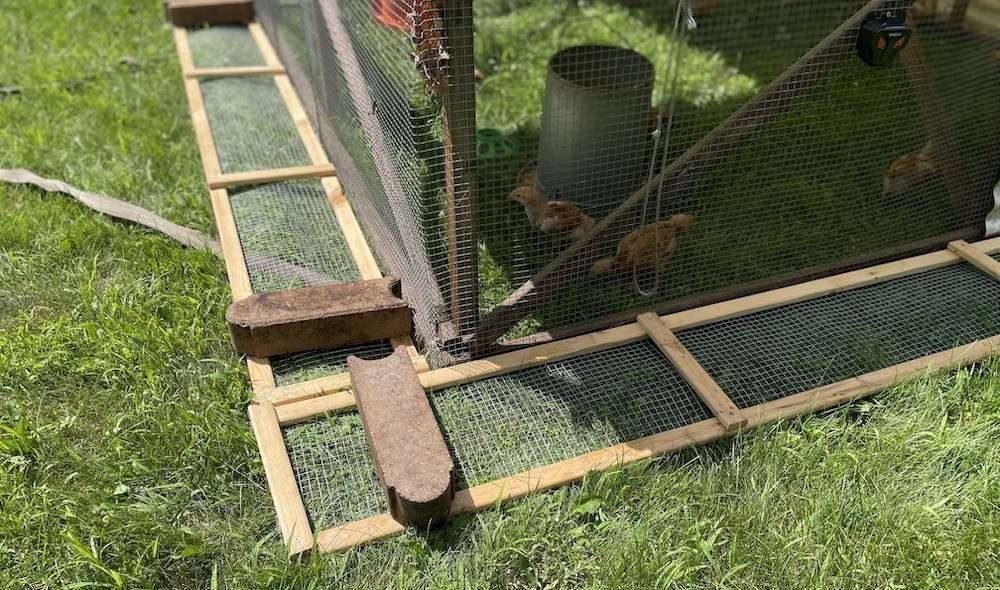
Other Tips for a Predator Proof Chicken Tractor
If you really want to up your game on predator proofing your chicken tractor, here are some other elements that you can consider adding. I’ve put them in order in terms of effectiveness, cost and commitment. Start at the top and work your way down!
Sound Deterrent
Using sound is a simple, inexpensive and very effective way to keep predators away. The best sound to be emitting is the human voice since most predators are afraid of humans. Therefore, a simple waterproof radio set on a talk radio station can be a great tool to save your flock.
I love these models because they offer a solar panel to charge on sunny days, but also a hand-crank so you can juice it up as needed on cloudy days. If it’s really dead, you can quickly power it up by using the USB port in the house. Simply, set it on top of the chicken tractor so that it has sun exposure and let it do the work for you!
I want you to learn from my mistake. I originally ordered a “water-resistant,” solar-powered radio and it basically dies anytime it rains (which is pretty much all the time here in Minnesota). It also has a small battery and worthless solar panel, so I have to charge it daily. I’ve done further research and the one below is the one to get!
The Homesteading RD's Product Picks | |
This is one of the few waterproof (IPX5), solar-powered radios on the market! I wouldn't fully submerge it, but it should be able to sit out in the rain. It also features a handcrank and USB-c charge port in case there's a string of cloudy weather. This radio has the largest battery on the market, offering 20 hours of playtime when charged. When you aren't running chickens, this would also be a great tool in your survival kit! | |
Visual Deterrent
Using a visual deterrent is an excellent way to spook off a predator before they even get close. The key with this type of deterrent is utilizing something that looks like a predator, to the incoming predator. Most predators are careful and wary of their surroundings. If anything seems “off” or questionable, they’ll likely move on.
The Homesteading RD's Product Picks | |
This is THE best predator deterrent light on the market. It is a bit more expensive, but you only need one with the 360 degree radius coverage from 9 LED bulbs that reach up to 1 mile away. It also has a random flashing pattern, making it exceptionally effective. Waterproof, powered by a 6V battery and automatically turns on at night. | |
If you are looking for an inexpensive & simple option, these solar powered predator lights are excellent! Sold in packs of 2 and 4; you will need more than 1 since these lights are directional. I personally use this one and have one mounted on each side of our chicken tractor. They store up power during the day, then start flashing at night. | |
Smell Deterrent
Most predators have an amazing sense of smell, so utilizing this inexpensive option to your advantage can be useful. Every predator in nature also has their own set of predators that they need to keep an eye out for, which is typically a coyote or wolf.
Therefore, spraying coyote or wolf urine around your chicken tractor will likely be effective in forcing smaller predators like fox, racoons or weasels to take a wide berth around your property. Also, larger predators like coyotes and wolves are territorial, so if they detect another’s presence, they’ll likely steer clear.
The Homesteading RD's Product Picks | |
PredatorPee Coyote Urine creates the illusion that a coyote is nearby! Reapply the spray around your perimeter weekly, or after a rain. Saturate the provided tags and hang them in select locations as well - if protected from rain, the scent will last for a while! | |
PredatorPee Wolf Urine creates the illusion that a wolf is nearby! Reapply the spray around your perimeter weekly, or after a rain. Saturate the provided tags and hang them in select locations as well - if protected from rain, the scent will last for a while! | |
Physical Deterrent
When all else fails, it’s time to add another layer of physical protection. There’s nothing that a good electrical zap won’t fix! It’s an expensive addition, but very effective. It can be as simple as a string of hot wire along the bottom of the chicken tractor, or as complex as a moveable electric fence with a solar powered unit to secure the entire yard area.
The Homesteading RD's Product Picks | |
Installs in approximately 15 minutes and is easy to move as your chickens make their way through the pasture. Effectively repels coyotes, foxes, dogs and bears when properly energized! I have a similar unit around my vegetable garden and it works great when powered with the unit below! | |
I use this same unit to power my electric netting around my garden and it works very well to keep the racoons out of my corn! It sends out electric pulses and is strong enough to power 25 miles of fencing! A little on the pricy side, but it is an excellent product. | |
Looking for a simple hot wire to string along the base of your chicken tractor? As long as you have access to power, this is a very affordable and simple option! | |
Livestock Guardian Dog
A good livestock guardian dog (LGD) is likely the very best protection strategy that you can implement. However, this decision shouldn’t be made lightly. LGDs are typically 100+ lbs and they need to be kept busy with jobs to do and flocks to protect, otherwise they can become trouble.
A livestock guardian dog should not be viewed as a traditional pet, and instead allowed to carry out their work 24/7. They typically live outdoors year-round and they love it! They are fierce protectors of their flock and not very welcoming to visiting dogs, or the postman.
Lastly, expect nighttime barking as their protection strategy and be aware that LGDs have a tendency to “patrol” the surrounding area. Therefore, if you are on a small acreage, your neighbors may not appreciate this. LGDs are best used in rural farm areas.
Common livestock guardian dog breeds
- Anatolian Shepherd
- Great Pyrenees
- Komondor
- Kuvasz
Want More Information on Raising Pastured Meat Chickens?
I’ve got you covered! Check out my comprehensive course “Raising Pastured Meat Chickens: From Chick to Drumstick” where I teach you everything you need to know from what breed to raise, what supplies you need and how to butcher them humanely (with videos!).
Other Articles You’ll Love
- Why You Should Raise Red Ranger Chickens
- The 5 Best Chickens for Meat and Eggs (Dual Purpose Breeds)
- The 7 Best Meat Chickens for Your Homestead
Conclusion
It’s rare to raise poultry and never have a run-in with a predator, but I’m hopeful that these strategies will help reduce the risk. We know that the fox is still around (via game cam and neighbor reports). So far we haven’t had any issues! They seem to be working.
Losing poultry is always heartbreaking and can be a large financial loss as well. Spending a little extra time and money to protect your flock is never wasted!
*Information in this article was referenced from personal experience and/or from my favorite chicken book Storey’s Guide to Raising Chickens, unless otherwise noted.

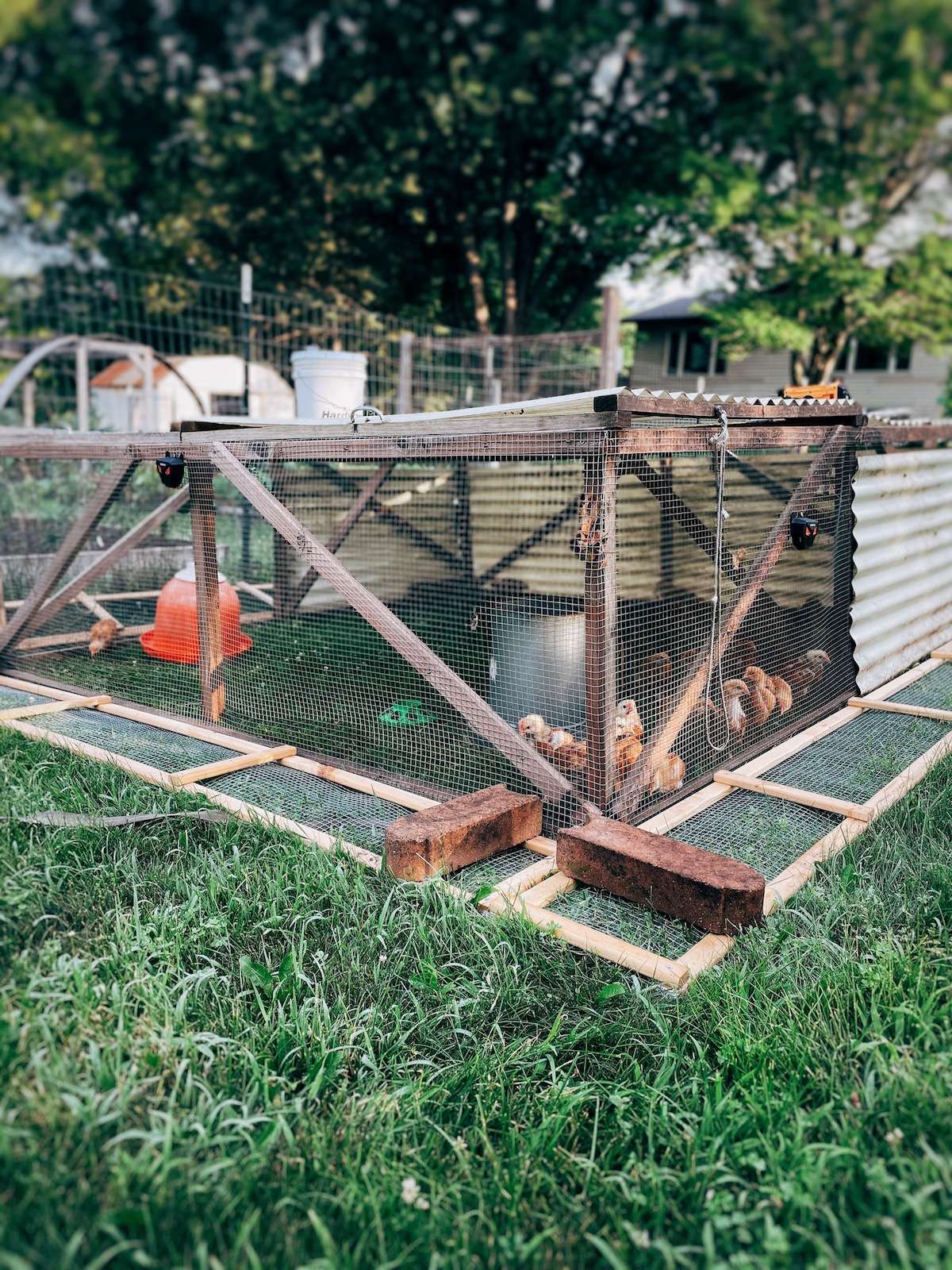

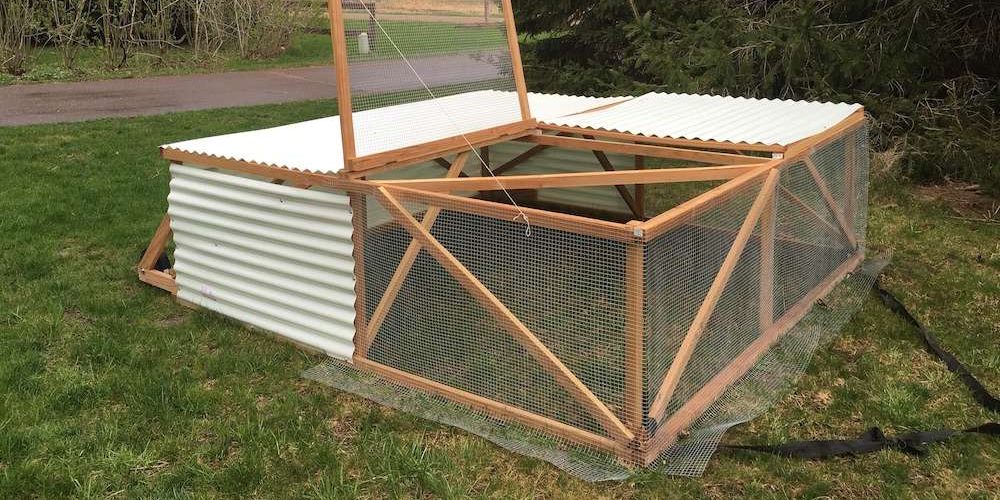
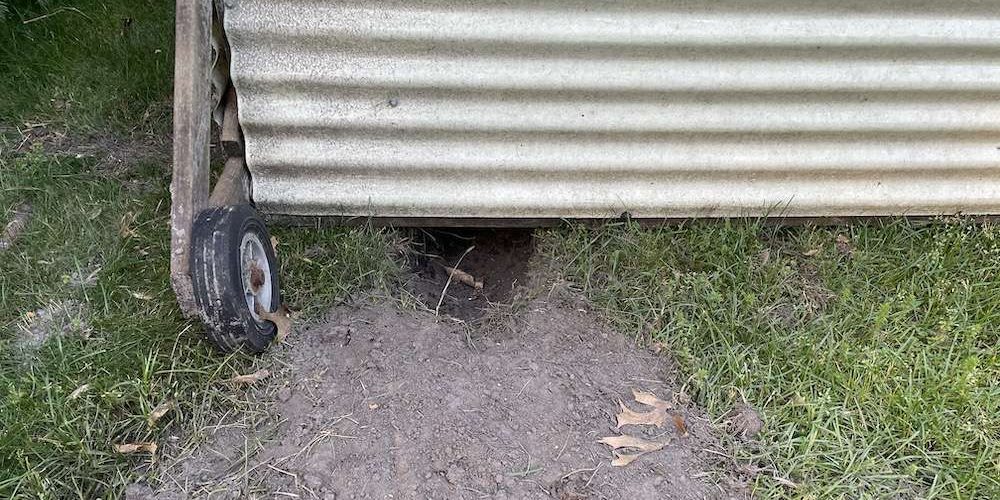
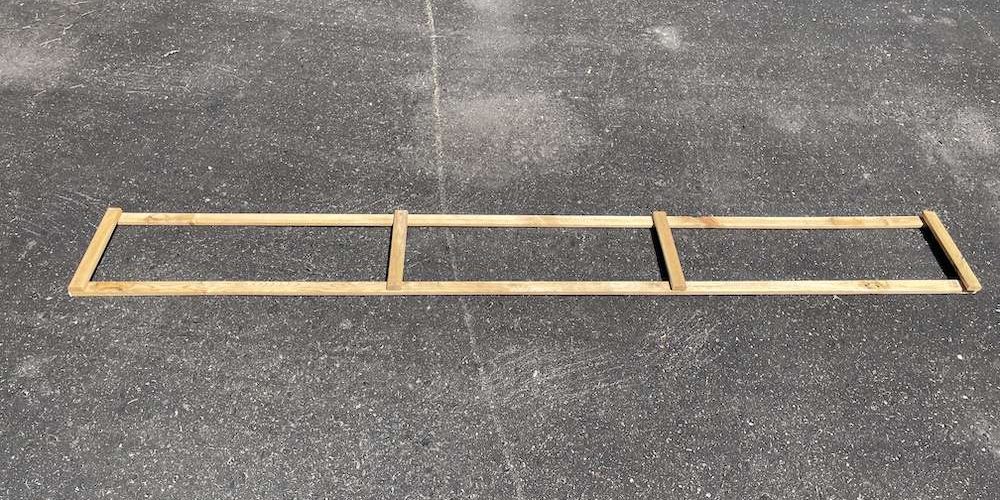
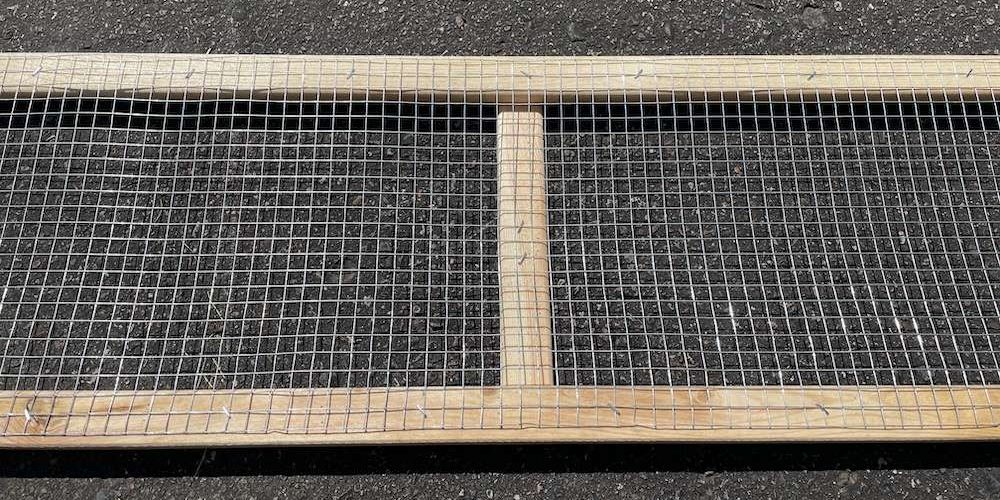
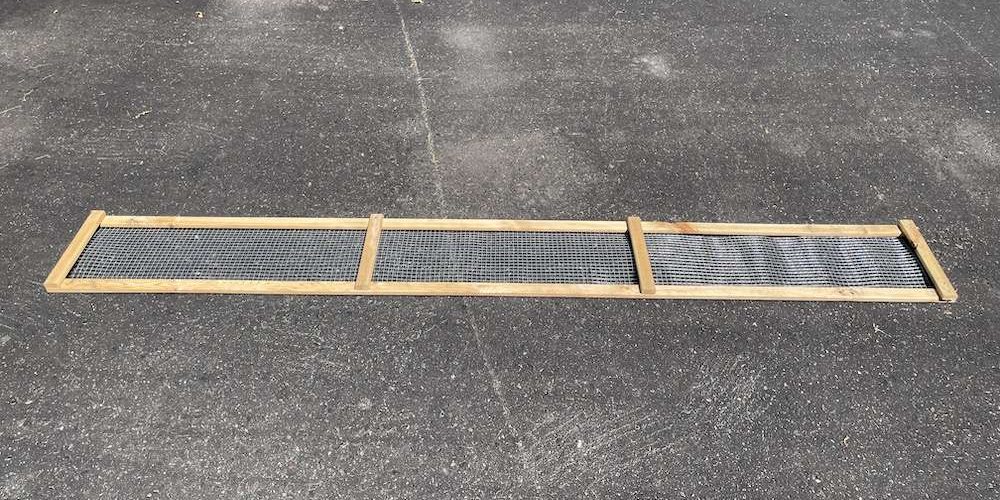








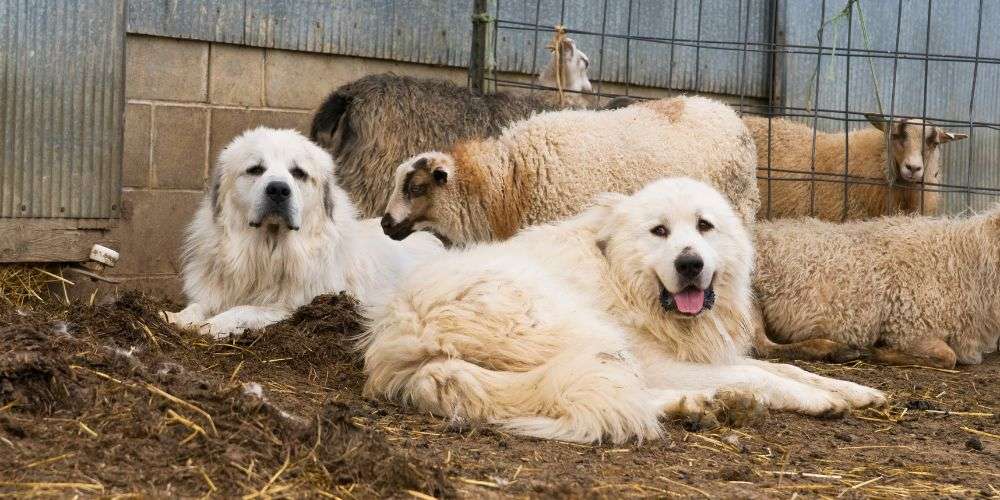



Hey, great ideas but it’s definitely not for us. Snakes and cane toads are a huge problem here in North Queensland and that solution won’t work. They will dig under any gap. For thus reason, tractors aren’t really practical. We have found that wore all the way around and under the pen, then bury the wire, then let the choke out during the day when they’re supervised. They have to be watched cos we also have birds of prey!! So we can’t win here. Yes, it’s true, everything is out to kill us in Queensland, including the creatures that can’t kill you!! 🤣
We had chickens a couple of years ago till we lost them to predators. Since then, we’ve built a new and are about to jump back in to raising chickens for the eggs.
I’ve looked at several ideas, including one that put the wire all along the bottom. The obvious downside to this would be the chickens being unable to scratch or injuring themselves. Then I saw your idea and had a thought, “why not combine these two ideas?!” That is, do the skirting, but do it on the INSIDE of the tractor and make it permanent. With a 6′ wide by 12′ long tractor, that still gives the chickens a 4′ x 10′ area to scratch and still protect them from predators trying to dig underneath.
Just wanted to say thanks for the idea.
That’s a great idea, too! However, I worry that if the chickens are standing on the skirts on the inside when you want to move the tractor… their weight may be too much, plus they might get injured toes. Might be worth a try, though!
How about moving the tractor after the chickens have roosted. That works
There are no roosting bars (nor should there be) in a meat chicken tractor. It can cause breast blisters.
What keeps coons, weasels or minks from digging under the skirts and still getting under the tractor to where the chickens are?
The skirts are fairly wide, so it’s pretty unlikely that they’d dig such a long tunnel to get there. Possible, but not likely.
Instead of paying for coyote pee, just tell your dear husband (or older son) to water the grass near the chicken coop. Dogs/coyotes will smell that it is his territory and keep away.
I want to to thank you for this good read!! I certainly loved every little bit of it. I have you bookmarked to look at new things you postÖ
You’re welcome and I’m so glad that you found it helpful. Glad to have you here 🙂
I’m going to blow your mind, maybe…. let’s “manually automate” those skirts.
Step 1- Hinge the skirting to the tractor so it can be lifted up flat to the tractor sides.
Step 2- Screw in eye-bolts to the edges of the skirting to tie cordage.
Step 3- Run that cordage up, through another eye-bolt, and to a central area on the back of the tractor.
Step 4- Attach all the cords together so they can all be pulled at the same time.
Step 5- When you’re ready to move the tractor, pull all the skirts up with the cords, move, and then release the skirts again.
(I hope you understood what I meant, and I hope it works for you (or anyone reading along)!)
(PS- Sorry for the novel in your comments. LOL)
Yes!!! We are on the same wavelength. We’re planning to make this upgrade to allow hinge-able no-dig guards this winter 🙂 I hadn’t thought of stringing them all together with cords for a SUPER easy step, though! Thank you!
I am sorry you loss those chickens. Thats awful! Great article & very informative.
Thank you – it’s been a tough year! So sad for the little ones. Hoping our new design will keep them safe!
This is a great concept!
Thank you! It’s working well so far!
This is great! Thankfully, our predators haven’t figured out how to dig under our current tractor. But I’m going to get this over to the hubbins to make sure the predators CAN’T dig under.
It’s such an easy thing to add; I wish I had thought of it sooner! Good luck
LGDs are the best BUT I know not everyone can have them where they live. These movable skirts are a great idea!
Thank you! They’ve been working well so far 🙂
I’m so sorry you lost all those chicks. But I am impressed with the modifications you made to prevent it from happening again.
Thank you; it’s been a rough summer with their loss. I’m hopeful that these modifications prevent any future issues!
Great article, have to show this to my husband! ☺️ Thank you
Thank you! Have a great summer 🙂